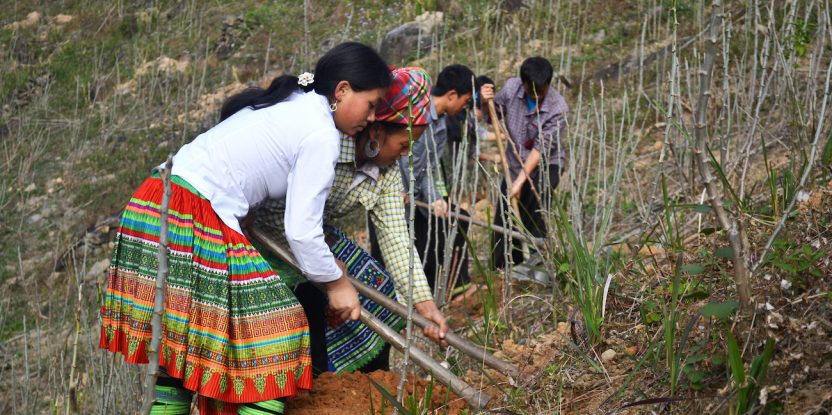
Coffee agroforestry systems in Vietnam have significant capacity to reduce greenhouse gas emissions by sequestering carbon and reducing the need for fertilizers, fungicides and other agricultural inputs, according to new research.
Women involved in a study led by the Center for International Forestry Research and World Agroforestry (CIFOR-ICRAF) in northwest Vietnam, tended toward considering more diverse characteristics than men when they selected trees, a finding researchers attributed to differing socio-economic roles.
While men favored timber trees, which have long been recognized for their ability to sequester carbon, women leaned toward fruit trees, the relative benefits of which – particularly in terms of distributing them throughout coffee monocultures – are less well known.
“Our findings indicate that the viewpoints of both men and women should be taken into consideration as countries look for ways to boost their tree cover,” said Elisabeth Simelton, a climate change scientist and lead author on the report titled “Beyond carbon sequestration – local knowledge about tree functions: Case study from male and female Arabica coffee farmers in Vietnam.”
Fruit trees are likely to have lower sequestration rates, not only because they are smaller than timber trees, but also because they are often grafted and pruned, she said. On the other hand they are also typically more long lasting than fast growing timber species, which are often cut in four- to five-year rotations with negative consequences for carbon storage and soil health.
Worldwide, tree planting initiatives are increasing, designed to help combat climate change and contribute to meeting Nationally Determined Contributions (NDCs), which are a key part of the U.N. Paris Agreement strategy to limit post-industrial warming to well below 2 degrees Celsius and pursue efforts to limit it to 1.5 degrees Celsius.
Each country is required to provide data on greenhouse gas emissions and reductions targets it aims to meet.
In 2020, the prime minister of Vietnam declared the country would plant 1 billion trees by 2025. After a revision of 18 of its NDCs in 2020 with contributions from CIFOR-ICRAF, the country – which was the second biggest coffee producer that year – made a commitment to simultaneously promote gender equality.
A technical assessment determined that sequestered carbon in the country’s coffee agroforestry systems was up to three to four times higher than in coffee monocultures.
However, while expanding agroforestry could substantially accelerate efforts to meet national targets, it is also perceived as a potential hindrance to achieving greater gender and social equality.
Scientists with CIFOR-ICRAF, contrasted two hypothetical tree-planting strategies, examining how a gender and social inclusion-oriented livelihoods perspective could contribute to the process of tree selection as Vietnam ratchets up its ambition.
“In this case, it was women who gave reason to widen the scope of potential agroforestry trees, but in another it could be men – without asking both and understanding their motivations, we would never know,” she added.
Local and Indigenous knowledge are key and ensuring both women and men’s voices are heard in local consultations on tree selection so that their preferences and needs are met, can yield a wider range of multipurpose tree species.
Although women and men have similar perceptions of the benefits provided by trees in agroforestry systems, women were found to consider a greater number of factors, including their impact on pests and disease, microclimate regulation and shade.
Women select a wider repertoire of trees to include in agroforestry systems. “The fact that soil fertility, pest and disease benefits were part of women’s intuitive considerations, reflects women’s active engagement in agriculture management,” Simelton said, adding that it could also indicate that they select less labor-intensive trees or those where efforts to tend them do not outweigh the benefits.
“In some other areas, women give ‘shade’ trees a high score because they get less tired working in the shade, allowing them to conserve energy for other activities, including household work.”
To reach their findings, scientists interviewed 53 male and 53 female Arabica coffee growers in two villages populated by the Thai ethnic minority in the area where coffee has been cultivated for decades as monoculture and in agroforestry systems with fruit and trees.
Out of a list of 12 fruit, seven timber and four other tree species, farmers selected nine preferred and ranked them according to 13 benefits, including economic and ecological characteristics. Only 18 of 24 species – those chosen by at least 10 participants were included in the analysis.
Women and men scored similarly on tree functions, Simelton said. The amount of fertilization it required, its ability to function as a wind break and produce mulch, were benefits most agreed on. Farmers also mentioned soil health and related undesirable tree-coffee interactions leading to competition for nutrients and soil moisture.
“Overall women considered more factors for their preferences, which resulted in a more diverse shortlist of potential trees for agroforestry and afforestation,” she said. “Getting women and men farmers involved in tree selection from the beginning helps with negotiating short-term mitigation and development goals, and a broad range of diverse bundled agroecosystem functions.”
We want you to share Forests News content, which is licensed under Creative Commons Attribution-NonCommercial-ShareAlike 4.0 International (CC BY-NC-SA 4.0). This means you are free to redistribute our material for non-commercial purposes. All we ask is that you give Forests News appropriate credit and link to the original Forests News content, indicate if changes were made, and distribute your contributions under the same Creative Commons license. You must notify Forests News if you repost, reprint or reuse our materials by contacting forestsnews@cifor-icraf.org.